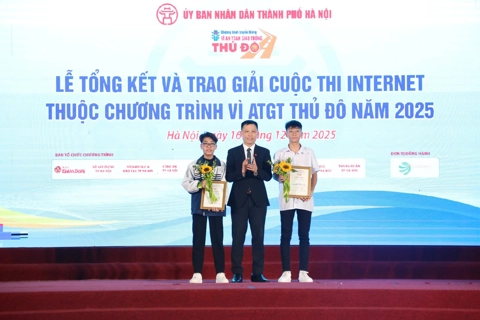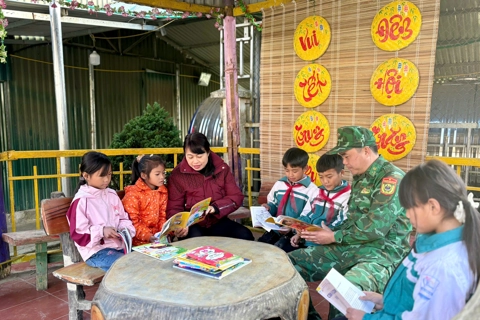Digital transformation in vocational education: Key for future growth of Vietnam
Upskilling Vietnamese workers, especially migrant ones in the industrial areas matters a lot to bridge the skill gap in human resources toward a sustainable future.
Improving the skills of Vietnamese workers in the rapidly changing labor market is crucial to the country’s development amid fast digitalization, Park Mihyung, the International Organization for Migration (IOM) Chief of Mission, said at a conference held in Hanoi this week to gain international expertise on the issue.
| Park Mihyung, the International Organization for Migration (IOM) Chief of Mission, said at the event held in Hanoi on August 25. Photos: IOM Vietnam |
“Investing in skills development in Vietnam is very important as it helps people get better jobs and work more productively, which makes the country stronger in the world economy,” Park Mihyung said at the completion of the two-year project on supporting the Government of Vietnam in digital transformation of labor through vocational education.
In fact, the rapid transformation of industries and societal structures observed in Vietnam in recent years has increased the sense of urgency in understanding the changing jobs landscape and aligning the conventional vocational education and training system to meet the actual skills demands.
Necessity
Despite the continued strong economic growth, the high youth unemployment rate in the country (7.61% compared to the national average of 2.25%) has been raising concerns for policymakers.
It results in national plans and policies that prioritize Technical and Vocational Education and Training (TVET) reform, reskilling and upskilling programs, and related initiatives for improved labor productivity.
For that reason, IOM in Vietnam and the General Directorate of Vocational Education and Training (DVET) under the Ministry of Labour, Invalids and Social Affairs conducted a two-year project that promoted free-to-access learning courses via online learning platform www.congdanso.edu.vn.
Starting in 2021, the project “Supporting the Government of Vietnam in the Digital Transformation of Labour through Enhancing Technical and Vocational Education and Training” focused on addressing the immediate skills needs of the current workforce while showcasing the potential of online learning platform to relevant stakeholders from TVET instructors to students, workers, and policymakers.
Over the past two years, it attracted more than 15,100 people since its launch and contributed to upskilling of Vietnamese workers, especially migrant workers in the industrial areas.
The platform and key digital skills learning courses were developed in partnership with Microsoft, which has been assessed as a successful example of public-private partnership in this area of workers' skills development, where close collaboration between policymakers and industry leaders is critical for sustainable impact.
For the Government of Vietnam, it's essential to upskill labor forces to increase their resilience and adaptability to the socio-economic shocks, which have been significantly affecting the employment structure. In this regard, the government is attempting to promote digital transformation in all sectors, including Technical and Vocational Education and Training, utilizing digital capacity to improve labor productivity and efficiency of people of working ages, especially vulnerable groups.
| Equipping digital skills among young people is crucial for a better future in Vietnam. |
Significant results
Commenting on the effectiveness, Park Mihyung shared that the e-learning platform improves access for low-skilled workers and migrant workers to gain essential skills, such as technical, soft, and digital skills. In addition, this reduces their vulnerability and helps them navigate in the digital environment, making them more adaptable and resilient.
The project targeted TVET institutions and industrial areas in Thai Nguyen, Quang Nam, Dong Nai, and Binh Duong with 163 instructors from 50 TVET institutions in the four target provinces were trained.
They then rolled out hybrid skills learning sessions—introducing online learning platforms and incorporating online courses in their teaching—for almost 3,000 students and workers.
Under this project, 31,100 course completions on digital, soft, job application, and entrepreneurship skills were recorded on the platform. Nearly 26,000 certificates were issued by Microsoft for digital literary skills, which attracted the most significant number of users.
“The online learning platform is just one of the prime examples of how IOM, the Government agencies, and the private sectors collaborate to create innovative solutions,” Park Mihyung added. “Together, we are supporting Vietnam’s goal of elevating its vocational education to gradually match top regional countries by 2030, with a vision to 2045.”
The project also supported the DVET in producing “Reference Book on Digital Transformation in Vocational Education and Training”, which aims to provide the national TVET policymakers and relevant stakeholders with practical guidance in exploring different priorities and issues related to the digital transformation for TVET system.
For example, the book presents six essential elements of the digital transformation ecosystem. It illustrates school-based administrative procedures to be simplified if the data collection and analysis system is used and connected.
This project is a premise for the work of digital transformation and improving Vietnamese workforce's digital capacity in the coming time.
IOM and DVET will continue to leverage and update the online learning platform and toolkits developed from the project to contribute to skills development for the Vietnam labor force, and engage with various stakeholders, including companies and employers, to expand this model.












